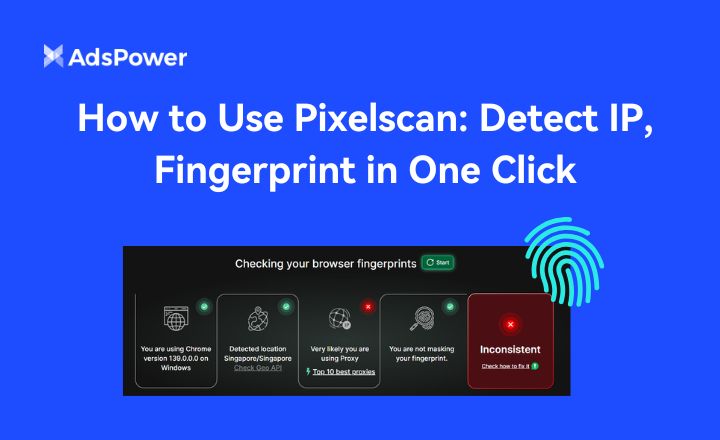Cross Browser Fingerprinting: User Tracking On Steroids
A University of Washington study on web tracking behaviors from 1996 to 2016 reveals that 75% of most popular websites track users. This also includes tracking through browser fingerprinting.
If that wasn’t worse already, researchers have come up with a more invasive tracking technique called cross browser fingerprinting. So if you were switching browsers to evade fingerprinting, this technique has caught you.
While collecting device and software information serves purposes like authentication and personalized services, too many metrics are collected solely for browser fingerprinting.
This article explores cross browser fingerprinting, its risks, and practical measures you can take to protect yourself against this invasive tracking technique.
What is Cross-Browser Fingerprinting?
Cross browser fingerprinting is a sophisticated technique used to track users across multiple web browsers on the same device.
Unlike traditional browser fingerprinting, which collects information from a single browser to identify a user, cross-browser fingerprinting takes this a step further by gathering unique identifiers from various browsers to create a more comprehensive profile of an individual's online behavior.
The main difference between traditional and cross browser fingerprinting lies in their scope and accuracy. Traditional fingerprinting is limited to the data from one browser. For example, it might look at your browser type, the extensions installed, and certain settings like fonts and screen resolution.
This method has its limitations because if you switch browsers, your digital fingerprint might look different, giving users some level of privacy and making it harder to track them consistently.
Cross browser fingerprinting overcomes these limitations by identifying patterns and features that are unique to your computer, such as hardware configurations, graphics card details, and even how your device handles WebGL tasks.
By combining data from multiple browsers, it creates a more stable and reliable way to identify users, even if they switch browsers frequently.
With cross browser fingerprinting researchers aim to solve several problems. Primarily, it's designed to improve the accuracy of user identification across different platforms, which is crucial for security and authentication processes.
For instance, it can enhance multi-factor authentication systems by providing an additional layer of security that verifies the user's identity across different browsers.
However, while it boosts security, it also raises significant privacy concerns, as it can potentially expose individuals to more invasive tracking and profiling by advertisers or malicious entities.
How Cross Browser Fingerprinting Works?
Cross-browser fingerprinting tracks users across different web browsers by exploiting consistent device and software attributes. This process goes deeper than traditional fingerprinting by not only targeting one browser but multiple ones used on the same machine.
Technologies and Methods
Let's explore the technologies and methods used in cross-browser fingerprinting and the specific attributes that it relies on.
1. Hardware and OS Level Features:
This technique leverages unique features from the operating system and hardware, like graphics cards and CPUs. These attributes are generally consistent across different browsers on the same device and provide a stable foundation for fingerprinting.
-
GPU Details: Attributes such as the model of the GPU, its driver version, and how it renders graphics tasks remains the same, irrespective of the browser used. Cross browser fingerprinting derives this information from how the device handles complex graphical tasks.
-
Operating System: The OS version and its configuration details are generally the same across all browsers on the device.
-
System Hardware: Attributes like the number of CPU cores, the presence of certain sensors, and the system’s memory capacity are also detected since these elements do not change with different browsers. This information can be discerned through how a browser handles multi-threading tasks.
-
Installed Writing Scripts and Fonts: The presence of certain writing scripts and the list of fonts installed on a system can provide a fingerprinting vector. These are less likely to change between browsers on the same device and provide a stable basis for identifying a machine.
-
Media Devices: Information such as the way a device's media hardware (microphones, speakers, and cameras) and associated software stack handle sound can also be used for fingerprinting, as access permissions and capabilities often remain constant across browsers.
-
Timezone and Language: These settings are often consistent across browsers on a single device.
By prompting the browsers to perform tasks that rely on these underlying functionalities, cross browser fingerprinting can gather detailed information that remains consistent across different browsers.
2. Rendering Tasks:
Tasks are designed to utilize different aspects of the device's capabilities, such as GPU rendering through WebGL and canvas elements. These tasks are tailored to reveal details about the hardware's behavior in processing complex graphics tasks.
Since these tasks are handled similarly by the hardware regardless of the browser, they can be used to identify a device across different browsing platforms.
3. API Calls:
The method utilizes API calls to extract information about system fonts, audio stacks, and other configurations that tend to be consistent irrespective of the browser being used.
This includes tasks that may assess how a device handles audio processing or what fonts are installed, both of which can differ significantly from system to system but are consistent across a user's browsers.
Risks and Privacy Concerns
Cross-browser fingerprinting, while technologically advanced, brings with it significant privacy concerns. Below are the key issues associated with this advanced tracking technique.
Intrusive Tracking
Cross-browser fingerprinting enhances the ability to track users more persistently across multiple browsers. This undermines the common privacy practice of using multiple browsers to separate activities and avoid tracking.
Users who switch between browsers for personal tasks, work, or sensitive browsing might unknowingly have all their activities linked together, creating a comprehensive and intrusive user profile.
Privacy Invasion
One of the most pressing issues with cross browser fingerprinting is the erosion of user privacy. This method can piece together a person’s browsing habits, shopping behaviors, social media interactions, and even political and religious beliefs based on their online activities.
Such deep insights into personal preferences and behaviors violate personal space and pose a significant threat to individual privacy.
Unauthorized Data Collection
Cross browser fingerprinting collects data without the user's knowledge or explicit approval. By exploiting hardware and software configurations, trackers gather unique identifiers that many users are unaware are being disclosed.
This not only includes general information like device type and operating system but can also extend to more detailed data such as graphics performance, installed fonts, and system configurations.
Lack of Control And Potential Misuse
There is a lack of transparency in how cross-browser fingerprinting is implemented and how the collected data is used. Users typically have little to no control over what information is collected and how it is stored or shared.
The information obtained through cross-browser fingerprinting can be misused in various ways. Advertisers might use it to target users aggressively, while cybercriminals could exploit this data for identity theft or more targeted attacks. The potential for misuse is significant, given the richness and accuracy of the data collected.
The unauthorized nature of this data collection poses significant ethical concerns, as users are not given the opportunity to opt out or control how their data is used.
3 Tips to Avoid Cross-Browser Fingerprinting
While cross-browser fingerprinting presents serious privacy challenges, there are effective anti-fingerprinting measures and tools available to help users avoid browser fingerprinting. Here are some of the practical anti-fingerprinting tips to protect your privacy online.
Install Privacy Extensions
Using privacy-focused browser extensions can help shield your online activity to some extent. Extensions like WebRTC Leak Prevent, CanvasBlocker, and Chameleon offer protection against certain browser fingerprinting techniques.
Regularly Clear Cookies and Cache
Regularly deleting your browser cookies and cache disrupts tracking by removing stored data that could be used to identify you. This practice prevents trackers from continuously collecting and refining their profile on your online behavior.
Adjust Browser Settings
Increase your privacy by adjusting the settings in your browser to limit data exposure. Disable features that share your location, control which sites can use JavaScript, and turn off ad personalization settings. These small changes can make it harder for cross browser fingerprinting to gather consistent data across browsers.
Anti-Fingerprint Browser: The Ultimate Solution
One of the most effective countermeasures against cross browser fingerprinting is using an anti-fingerprint browser. These browsers are designed to hide your digital footprints from websites you visit.
Among these specialized browsers, AdsPower is known as the best anti-fingerprint browser for offering the most robust anti-fingerprinting solution.
It allows users to easily modify a long list of browser fingerprint metrics such as the user agent, timezone, language, screen resolution, and much more.
Users can either manually tweak individual metrics or use the feature to generate random fingerprints. By randomizing the browser fingerprint, AdsPower significantly hinders websites from identifying and tracking your online activities consistently.
AdsPower is accessible to anyone concerned about their privacy. The browser comes with a free version as well as premium plans beginning at just $4.5 per month.
Simply sign up and download AdsPower and take the first step towards browser fingerprint spoofing.

People Also Read
- 8 Best Whoer Alternatives in 2026 ( Accurate & Private IP Check Tools)

8 Best Whoer Alternatives in 2026 ( Accurate & Private IP Check Tools)
Looking for a Whoer.net alternative? Discover our 2026 list of the 8 best IP check tools for accurate, private fingerprint analysis and enhanced onlin
- What Is WebRTC Used For? Does WebRTC Leak Your IP Address?

What Is WebRTC Used For? Does WebRTC Leak Your IP Address?
Learn what WebRTC is, what it's used for, whether it leaks your IP address, and how to stay protected with tools like AdsPower's WebRTC modes.
- What is BrowserScan? Check Fingerprints, IP Leaks & Stay Private

What is BrowserScan? Check Fingerprints, IP Leaks & Stay Private
What is BrowserScan? Find out how it detects IP leaks & unique fingerprints, plus tips for privacy with AdsPower.
- How Does AmIUnique Work and Is It Safe? Everything You Need to Know

How Does AmIUnique Work and Is It Safe? Everything You Need to Know
Discover how AmIUnique reveals your browser fingerprint, whether it's safe, the best alternatives, and expert tips to protect your online privacy.
- Pixelscan Review 2026: Features, Uses & Best Alternatives

Pixelscan Review 2026: Features, Uses & Best Alternatives
Pixelscan lets you check your IP and fingerprint; discover the best alternatives of Pixelscan to enhance security and privacy online.


